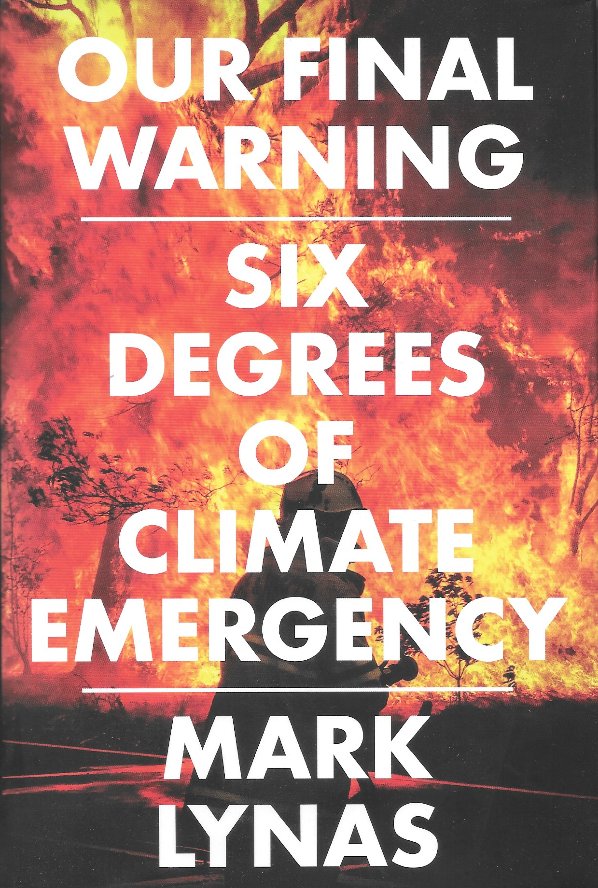The one sentence summary
We are living in a climate emergency and need to take radical action now, before it is too late.
WHAT THE BOOK SAYS

- Subtitled Six Degrees of Climate Emergency, this is an update on the author’s Six Degrees, published in 2007. He is now even more pessimistic about the planet’s prospects. The book moves through six scenarios, explaining the likely conditions and events if the planet increases in temperature from 1° hotter to 6°.
- 1°. We are already experiencing a range of unnerving developments, which include ice melting at too fast a rate, increasingly erratic weather patterns, ocean heatwaves, bleaching corals, frequent and larger flooding events, more severe hurricanes, bushfires, refugees escaping heat and famine, deforestation, global browning, and species moving to the poles at an average of 17km per decade or to higher altitude at 11m per decade.
- 2°. Arctic sea ice will completely disappear, creating the first ice-free North Pole for 3 million years. Fragmentation of the Antarctic ice sheet will deliver 5 metres of sea level rise, inundating major coastal cities such as London, Jakarta, New York, and Shanghai. Dengue fever will rise hugely, due to favourable mosquito breeding environments. Food production will suffer as many places become too hot to grow crops. Madrid’s climate would be like Marrakech, Reykjavik like Edinburgh, and Edinburgh like Lille. Sustained drought will come to the Amazon. 99% of all corals will be gone. Rain on snow events are especially dangerous to grazing animals because a layer of ice stops them reaching the plants underneath, leading to mass die-offs of reindeer and musk oxen.
- 3°. Meltwater will open up fractures at the base of the West Antarctic Ice Sheet (hydrofracturing), triggering major tsunamis. Temperatures of 50°C become the norm in many places such as India and Pakistan, as we exceed the deadly threshold – the point at which mortality rates increase significantly. 50% of the population will be annually exposed to heatwave conditions that can kill. Over a billion will be exposed to temperatures that exceed the workability threshold, where it becomes impossible to work safely outside, even in the shade. Crop yields decline drastically. 200m people a year will be affected by river flooding. This doesn’t equal more rainfall – just more dramatic events. Amazon dieback begins in earnest, permafrost melts to release catastrophic amounts of stored methane (100 billion tonnes of carbon by the end of the century). All of this creates positive feedbacks, making things get worse even faster.
- 4°. Substantial areas of the planet are biologically uninhabitable, becoming a lethal hothouse of dust, aridity and fires. More floods, more melting, more hurricanes, more harvest failure, more mass extinctions. These are all grey swans – events that we know can happen, but don’t really expect, unlike black swans which cannot be predicted. Both humidity and temperature pass a critical level – what scientists call a wet bulb temperature of 35°C. No amount of sweating will cool us down. Large scale feedbacks have now kicked in, turning the heating process into an unstoppable spiral. The Arctic is now in the melt zone and becomes a carbon bomb as 15 million square kilometres of thawing mush makes the world a net emitter of carbon.
- 5°. Humanity has now lost control of global temperatures and we are in heat shock. Food production is decimated, large areas are uninhabitable, and vast quantities of carbon are pouring out of the melting permafrost. A wasteland of rocky continents surrounded by stagnant oceans beckons. People and animals will clamour to inhabit climate refuges, where conditions are still just about tolerable. Most of the Mediterranean is transitioning into full-scale desert. The countries who stand to lose the most land through inundation include China, Russia, USA, Canada, Brazil, and Australia. 800 million people will be directly flooded out of their homes. The planet is now a hyperthermal hothouse – hotter than it has been for 50 million years. Rainforests start appearing in the arctic due to drastic polar amplification of warming. There are anoxic oceans (anoxia refers to abnormally low amounts of oxygen, so there is little life).
- 6°. Catastrophic failure. Interestingly, the author reports that there are very few scientific papers on this scenario, as though scientists are scared to envisage it – another form of denial. But the paleontological record tells us what it would be like. Cretaceous super greenhouses were characterised by super-heated, oxygen-starved, dead oceans, and globe-girdling, hyper-arid deserts in the mid- to low latitudes.
- Endgame. Global emissions are already double the permissible amounts that would stay under the 1.5°C target agreed in Paris. Even worse, investment that has already been committed to power projects and other carbon emitting machinery such as cars and planes mean that we won’t even achieve 2°C. We need to immediately: cancel all power plants that are planned, permitted or under construction; stop selling cars and trucks straight away – in fact, anything with an internal combustion engine such as home boilers, aircraft, shipping, cement kilns, and blast furnaces. Existing emitting infrastructure should be closed down before the end of its working life, and all carbon emitting vehicles removed. This is a political bitter pill and will leave many companies and governments with stranded assets, but it must be done.
WHAT’S GOOD ABOUT IT
- The rather benign term climate change is now being replaced with the more dramatic climate breakdown to reflect the severity of the situation.
- Climate justice suggests that richer, developed countries should foot the bill for damage-reduction measures elsewhere – the polluter pays principle.
- Eco-fascists are world leaders who police their borders rigidly but happily allow millions elsewhere to die from famine.
WHAT YOU HAVE TO WATCH
- This is a dense read full of facts, and very information heavy.
- Single digits of °C don’t have the same power to alarm as Fahrenheit. For example, 50°C = 122°F.
